Brendan Jou
A Versatile Diffusion Transformer with Mixture of Noise Levels for Audiovisual Generation
May 22, 2024



Abstract:Training diffusion models for audiovisual sequences allows for a range of generation tasks by learning conditional distributions of various input-output combinations of the two modalities. Nevertheless, this strategy often requires training a separate model for each task which is expensive. Here, we propose a novel training approach to effectively learn arbitrary conditional distributions in the audiovisual space.Our key contribution lies in how we parameterize the diffusion timestep in the forward diffusion process. Instead of the standard fixed diffusion timestep, we propose applying variable diffusion timesteps across the temporal dimension and across modalities of the inputs. This formulation offers flexibility to introduce variable noise levels for various portions of the input, hence the term mixture of noise levels. We propose a transformer-based audiovisual latent diffusion model and show that it can be trained in a task-agnostic fashion using our approach to enable a variety of audiovisual generation tasks at inference time. Experiments demonstrate the versatility of our method in tackling cross-modal and multimodal interpolation tasks in the audiovisual space. Notably, our proposed approach surpasses baselines in generating temporally and perceptually consistent samples conditioned on the input. Project page: avdit2024.github.io
LanSER: Language-Model Supported Speech Emotion Recognition
Sep 07, 2023



Abstract:Speech emotion recognition (SER) models typically rely on costly human-labeled data for training, making scaling methods to large speech datasets and nuanced emotion taxonomies difficult. We present LanSER, a method that enables the use of unlabeled data by inferring weak emotion labels via pre-trained large language models through weakly-supervised learning. For inferring weak labels constrained to a taxonomy, we use a textual entailment approach that selects an emotion label with the highest entailment score for a speech transcript extracted via automatic speech recognition. Our experimental results show that models pre-trained on large datasets with this weak supervision outperform other baseline models on standard SER datasets when fine-tuned, and show improved label efficiency. Despite being pre-trained on labels derived only from text, we show that the resulting representations appear to model the prosodic content of speech.
* Presented at INTERSPEECH 2023
Multitask vocal burst modeling with ResNets and pre-trained paralinguistic Conformers
Jun 24, 2022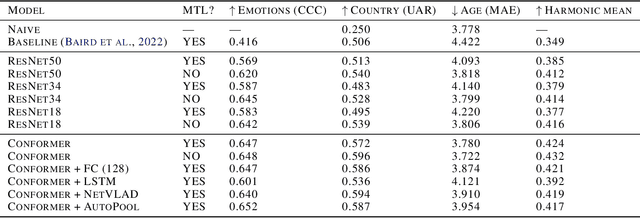
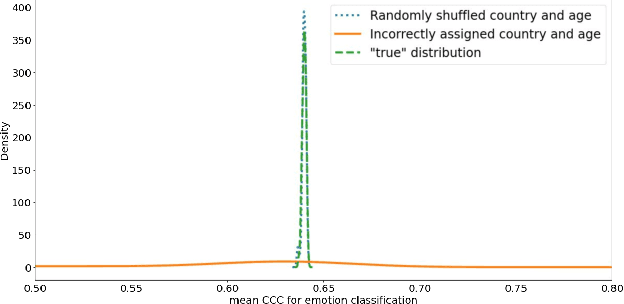
Abstract:This technical report presents the modeling approaches used in our submission to the ICML Expressive Vocalizations Workshop & Competition multitask track (ExVo-MultiTask). We first applied image classification models of various sizes on mel-spectrogram representations of the vocal bursts, as is standard in sound event detection literature. Results from these models show an increase of 21.24% over the baseline system with respect to the harmonic mean of the task metrics, and comprise our team's main submission to the MultiTask track. We then sought to characterize the headroom in the MultiTask track by applying a large pre-trained Conformer model that previously achieved state-of-the-art results on paralinguistic tasks like speech emotion recognition and mask detection. We additionally investigated the relationship between the sub-tasks of emotional expression, country of origin, and age prediction, and discovered that the best performing models are trained as single-task models, questioning whether the problem truly benefits from a multitask setting.
DISSECT: Disentangled Simultaneous Explanations via Concept Traversals
May 31, 2021



Abstract:Explaining deep learning model inferences is a promising venue for scientific understanding, improving safety, uncovering hidden biases, evaluating fairness, and beyond, as argued by many scholars. One of the principal benefits of counterfactual explanations is allowing users to explore "what-if" scenarios through what does not and cannot exist in the data, a quality that many other forms of explanation such as heatmaps and influence functions are inherently incapable of doing. However, most previous work on generative explainability cannot disentangle important concepts effectively, produces unrealistic examples, or fails to retain relevant information. We propose a novel approach, DISSECT, that jointly trains a generator, a discriminator, and a concept disentangler to overcome such challenges using little supervision. DISSECT generates Concept Traversals (CTs), defined as a sequence of generated examples with increasing degrees of concepts that influence a classifier's decision. By training a generative model from a classifier's signal, DISSECT offers a way to discover a classifier's inherent "notion" of distinct concepts automatically rather than rely on user-predefined concepts. We show that DISSECT produces CTs that (1) disentangle several concepts, (2) are influential to a classifier's decision and are coupled to its reasoning due to joint training (3), are realistic, (4) preserve relevant information, and (5) are stable across similar inputs. We validate DISSECT on several challenging synthetic and realistic datasets where previous methods fall short of satisfying desirable criteria for interpretability and show that it performs consistently well and better than existing methods. Finally, we present experiments showing applications of DISSECT for detecting potential biases of a classifier and identifying spurious artifacts that impact predictions.
BasisNet: Two-stage Model Synthesis for Efficient Inference
May 07, 2021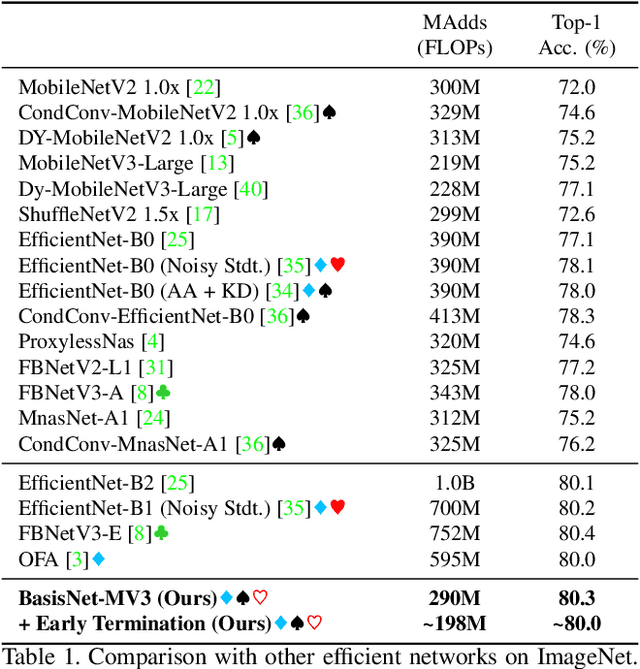
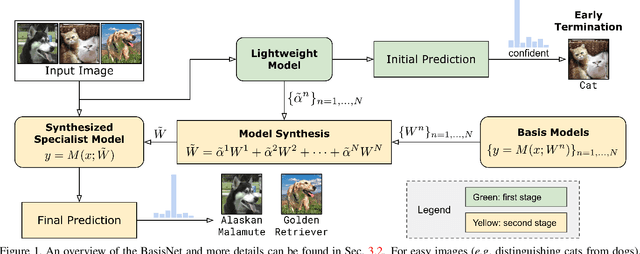


Abstract:In this work, we present BasisNet which combines recent advancements in efficient neural network architectures, conditional computation, and early termination in a simple new form. Our approach incorporates a lightweight model to preview the input and generate input-dependent combination coefficients, which later controls the synthesis of a more accurate specialist model to make final prediction. The two-stage model synthesis strategy can be applied to any network architectures and both stages are jointly trained. We also show that proper training recipes are critical for increasing generalizability for such high capacity neural networks. On ImageNet classification benchmark, our BasisNet with MobileNets as backbone demonstrated clear advantage on accuracy-efficiency trade-off over several strong baselines. Specifically, BasisNet-MobileNetV3 obtained 80.3% top-1 accuracy with only 290M Multiply-Add operations, halving the computational cost of previous state-of-the-art without sacrificing accuracy. With early termination, the average cost can be further reduced to 198M MAdds while maintaining accuracy of 80.0% on ImageNet.
Characterizing Sources of Uncertainty to Proxy Calibration and Disambiguate Annotator and Data Bias
Oct 05, 2019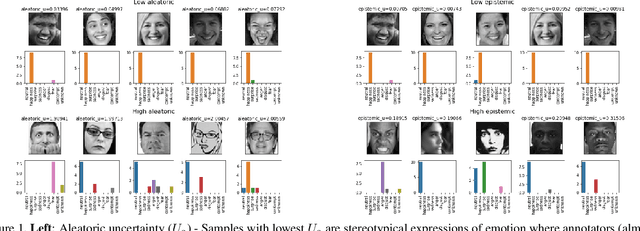

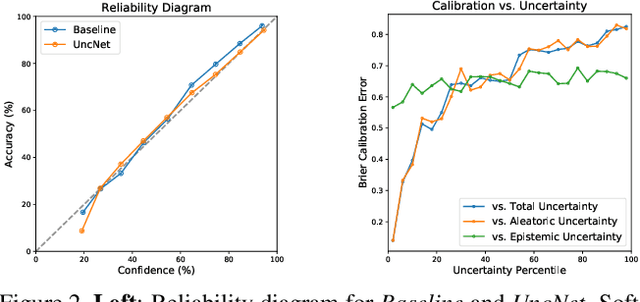

Abstract:Supporting model interpretability for complex phenomena where annotators can legitimately disagree, such as emotion recognition, is a challenging machine learning task. In this work, we show that explicitly quantifying the uncertainty in such settings has interpretability benefits. We use a simple modification of a classical network inference using Monte Carlo dropout to give measures of epistemic and aleatoric uncertainty. We identify a significant correlation between aleatoric uncertainty and human annotator disagreement ($r\approx.3$). Additionally, we demonstrate how difficult and subjective training samples can be identified using aleatoric uncertainty and how epistemic uncertainty can reveal data bias that could result in unfair predictions. We identify the total uncertainty as a suitable surrogate for model calibration, i.e. the degree we can trust model's predicted confidence. In addition to explainability benefits, we observe modest performance boosts from incorporating model uncertainty.
Skip RNN: Learning to Skip State Updates in Recurrent Neural Networks
Feb 05, 2018



Abstract:Recurrent Neural Networks (RNNs) continue to show outstanding performance in sequence modeling tasks. However, training RNNs on long sequences often face challenges like slow inference, vanishing gradients and difficulty in capturing long term dependencies. In backpropagation through time settings, these issues are tightly coupled with the large, sequential computational graph resulting from unfolding the RNN in time. We introduce the Skip RNN model which extends existing RNN models by learning to skip state updates and shortens the effective size of the computational graph. This model can also be encouraged to perform fewer state updates through a budget constraint. We evaluate the proposed model on various tasks and show how it can reduce the number of required RNN updates while preserving, and sometimes even improving, the performance of the baseline RNN models. Source code is publicly available at https://imatge-upc.github.io/skiprnn-2017-telecombcn/ .
More cat than cute? Interpretable Prediction of Adjective-Noun Pairs
Aug 21, 2017



Abstract:The increasing availability of affect-rich multimedia resources has bolstered interest in understanding sentiment and emotions in and from visual content. Adjective-noun pairs (ANP) are a popular mid-level semantic construct for capturing affect via visually detectable concepts such as "cute dog" or "beautiful landscape". Current state-of-the-art methods approach ANP prediction by considering each of these compound concepts as individual tokens, ignoring the underlying relationships in ANPs. This work aims at disentangling the contributions of the `adjectives' and `nouns' in the visual prediction of ANPs. Two specialised classifiers, one trained for detecting adjectives and another for nouns, are fused to predict 553 different ANPs. The resulting ANP prediction model is more interpretable as it allows us to study contributions of the adjective and noun components. Source code and models are available at https://imatge-upc.github.io/affective-2017-musa2/ .
From Pixels to Sentiment: Fine-tuning CNNs for Visual Sentiment Prediction
Jan 27, 2017



Abstract:Visual multimedia have become an inseparable part of our digital social lives, and they often capture moments tied with deep affections. Automated visual sentiment analysis tools can provide a means of extracting the rich feelings and latent dispositions embedded in these media. In this work, we explore how Convolutional Neural Networks (CNNs), a now de facto computational machine learning tool particularly in the area of Computer Vision, can be specifically applied to the task of visual sentiment prediction. We accomplish this through fine-tuning experiments using a state-of-the-art CNN and via rigorous architecture analysis, we present several modifications that lead to accuracy improvements over prior art on a dataset of images from a popular social media platform. We additionally present visualizations of local patterns that the network learned to associate with image sentiment for insight into how visual positivity (or negativity) is perceived by the model.
Deep Cross Residual Learning for Multitask Visual Recognition
Jul 20, 2016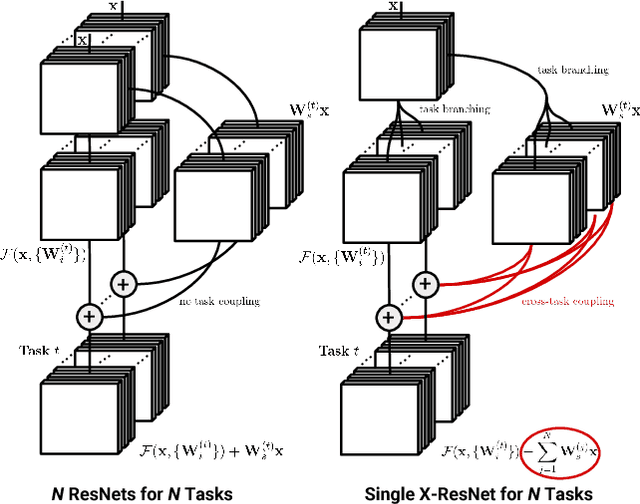
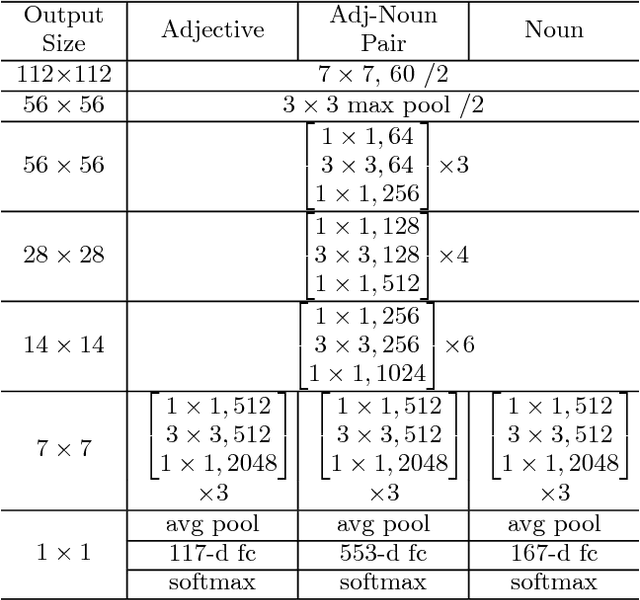
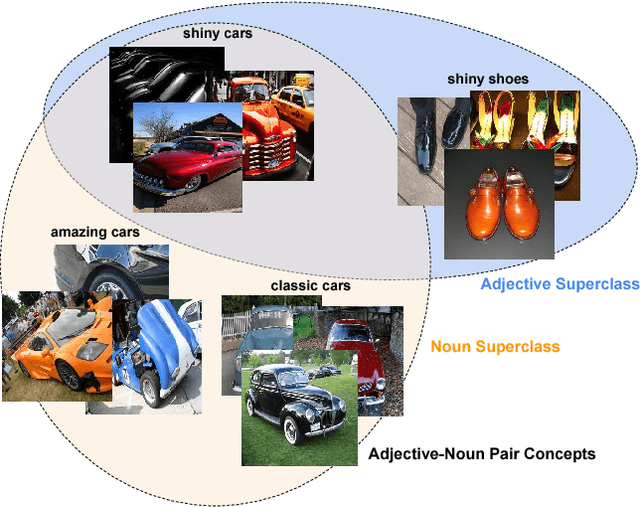
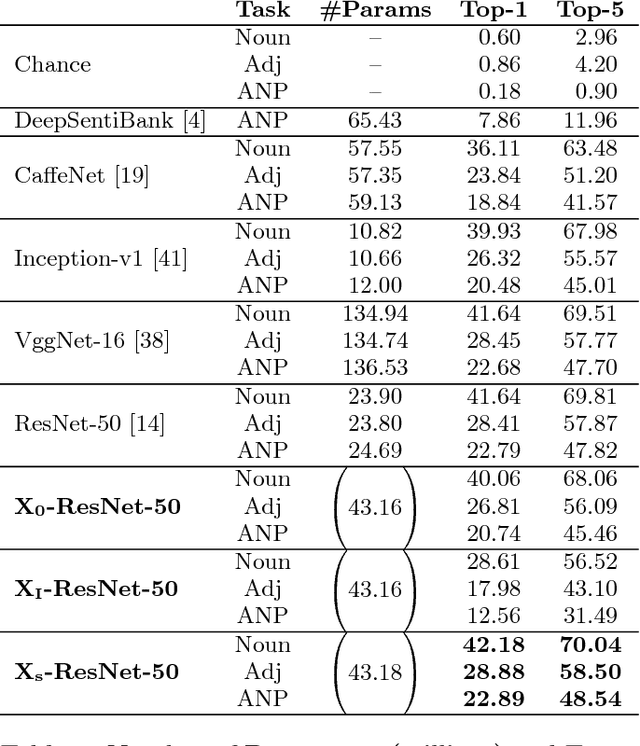
Abstract:Residual learning has recently surfaced as an effective means of constructing very deep neural networks for object recognition. However, current incarnations of residual networks do not allow for the modeling and integration of complex relations between closely coupled recognition tasks or across domains. Such problems are often encountered in multimedia applications involving large-scale content recognition. We propose a novel extension of residual learning for deep networks that enables intuitive learning across multiple related tasks using cross-connections called cross-residuals. These cross-residuals connections can be viewed as a form of in-network regularization and enables greater network generalization. We show how cross-residual learning (CRL) can be integrated in multitask networks to jointly train and detect visual concepts across several tasks. We present a single multitask cross-residual network with >40% less parameters that is able to achieve competitive, or even better, detection performance on a visual sentiment concept detection problem normally requiring multiple specialized single-task networks. The resulting multitask cross-residual network also achieves better detection performance by about 10.4% over a standard multitask residual network without cross-residuals with even a small amount of cross-task weighting.
 Add to Chrome
Add to Chrome Add to Firefox
Add to Firefox Add to Edge
Add to Edge